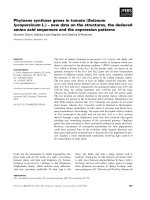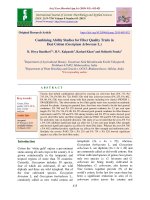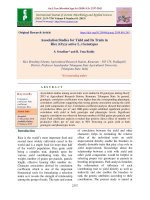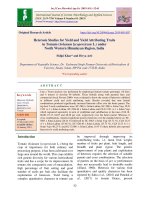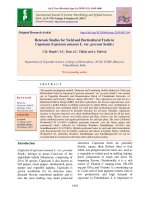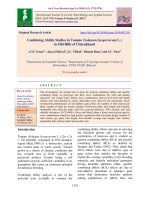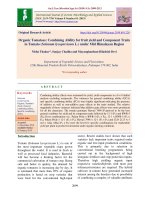Combining ability studies for growth and quality characters in tomato (Solanum lycopersicum L.)
Bạn đang xem bản rút gọn của tài liệu. Xem và tải ngay bản đầy đủ của tài liệu tại đây (264.68 KB, 5 trang )
Int.J.Curr.Microbiol.App.Sci (2018) 7(10): 2287-2291
International Journal of Current Microbiology and Applied Sciences
ISSN: 2319-7706 Volume 7 Number 10 (2018)
Journal homepage:
Original Research Article
/>
Combining Ability Studies for Growth and Quality Characters in
Tomato (Solanum lycopersicum L.)
Y. Madhavi1*, R.V.S.K. Reddy2 and C. Sreenivasa Reddy1
1
Department of Vegetable Science, College of Horticulture, Dr. Y.S.R.H.U, Rajendranagar,
Hyderabad – 500 030, India
2
Vegetable Reasearch Station, Dr. Y.S.R.H.U, Rajendranagar, Hyderabad – 500 030, India
3
Krishi Vigyan Kendra, Kalyandurg, Anthapuraram, Andhra Pradesh – 515 761, India
*Corresponding author
ABSTRACT
Keywords
General combining
ability, Specific
combining ability, Gene
action, Line and tester,
Tomato
Article Info
Accepted:
18 September 2018
Available Online:
10 October 2018
General and specific combining abilities (GCA and SCA) were estimated using six lines of
tomato (Solanum lycopersicum L.) and three testers and their F1 hybrids, bred in line x
tester fashion. The present study revealed that none of the parent was best combiner for all
the traits indicating differences in genetic variability for different characters among the
parents. Line x tester effect was found significant for all the characters under the study
except for plant height. The magnitude of gca and sca variances indicated importance of
additive as well as non-additive gene action with predominance non-additive action for all
the traits except plant height. Lines, LE-56 was found good general combiner for ascorbic
acid, total carotenoids, reducing sugars, total sugars and lycopene content; LE-62 for plant
height, TSS, reducing sugars and total sugars. Similarly tester, Punjab Chhuhara for total
carotenoids and lycopene; tester Pusa Gaurav was found to be good combiner for plant
height, reducing sugars and total sugars. F1 hybrids from cross combinations, LE-62 ×
Punjab Chhuhara were recorded with good specific combiner for number of primary
branches per plant, total carotenoids, reducing sugars, total sugars and lycopene; LE-64 ×
Punjab Chhuhara for ascorbic acid, total carotenoids and lycopene; EC-165749 X Pusa
Gaurav for TSS, reducing sugars and total sugars.
Introduction
Tomato (Solanum lycopersicum L.) an
important vegetable crop grown throughout
the world, is not only used as a fresh vegetable
but also for processing. Combining ability is
an effective tool, which gives genetic
information for the choice of parents in terms
of performance of their hybrids (Chezhian et
al., 2000). For developing hybrids, the most
important task for the plant breeder is the
choice of parental lines. The selection of
parents on the basis of per se performance
does not necessarily lead to desirable results
(Allard, 1960). It is, therefore essential to find
out the combining ability of desirable
genotypes to be involved in breeding
programme for effective transfer of desirable
genes in the resultant progenies. The objective
of present investigation was undertaken to
identify the best parental combination for
growth and quality characters in tomato.
2287
Int.J.Curr.Microbiol.App.Sci (2018) 7(10): 2287-2291
Materials and Methods
General combining ability and specific
combining ability effects
The present investigation was carried out at
the experimental farm of Vegetable Research
Station, Dr. Y.S. R. Horticultural University,
Rajendranagar, Hyderabad during 2010 2011. The parental material used in the line x
tester model, consisted of six lines viz., EC165749, LE-56, LE-62, LE-64, LE-65, LE-67
and three testers viz., d Punjab Chhuhara, Pant
T-3 and Pusa Gaurav. Crosses were made
manually using the standard procedure of hand
emasculation and pollination. All the 18
hybrids along with their corresponding nine
parents and three standard checks viz;
Lakshmi, US-618 and Arka vikas were
evaluated in a randomized block design with
three replications. Combining ability analysis
was done as per Kempthorne (1957).
Observations were recorded for plant height
(cm), number of primary branches per plant,
total soluble solids (ºBrix), ascorbic acid
(mg/100 g), total carotenoids (mg/100 g),
teducing sugars (%), total sugars (%) and
lycopene content (mg/100 g) to study the gene
action, general combining ability (gca) effects
of parents and specific combining ability (sca)
effects of hybrids in tomato.
Results and Discussion
Analysis for combining ability was carried out
for growth and quality characters and mean
sum of squares were presented in Table 1. The
analysis of variance revealed that the
treatments exhibited highly significant
differences among themselves. The parents as
well as crosses exhibited significant
differences for all the traits studied, whereas
parents vs. crosses exhibited significant
differences only for plant height, number of
primary branches per plant and ascorbic acid.
The interaction effects (Lines × Testers) were
found to be significant for all the traits except
for plant height.
Nature and magnitude of combining ability
effects provide guide line in identifying the
better parents and their utilization. The
summary of the gca effects of the parents
(Table 3) revealed that none of the parent
found to be good general combiner for all the
characters. Line, LE-56 was found good
general combiner for ascorbic acid (11.719),
total carotenoids (0.854), reducing sugars
(0.367), total sugars (0.353) and lycopene
(1.005). Line, LE-62 was observed good
combiner for plant height (24.524), TSS
(0.641), reducing sugars (0.613) and total
sugars (0.621). None of the lines exhibited
positive and negative significant gca effects
for number of primary branches per plant.
Among the testers, Punjab Chhuhara was
observed good combiner for total carotenoids
(0.569) and lycopene (0.662). Tester, Pusa
Gaurav was found to be good combiner for
plant height (6.835), reducing sugars (0.135)
and total sugars (0.140). None of the testers
exhibited positive and negative significant gca
effects for ascorbic acid.
In the case of sca effects, none of the hybrids
exhibited favourable sca effect for all the
characters (Table 4). Of all the crosses studied
none of the crosses found to be significant,
except LE-64 × Punjab Chhuhara (-16.03)
which recorded significant negative sca effect
for plant height. Hybrid, LE-62 × Punjab
Chhuhara was recorded with good specific
combiner for number of primary branches per
plant (1.388), total carotenoids (1.051),
reducing sugars (0.454), total sugars (0.430)
and lycopene (1.587). Cross combination, LE64 × Punjab Chhuhara was found to be good
specific combiner for ascorbic acid (6.559),
total carotenoids (1.288) and lycopene (1.478).
Cross, EC-165749 X Pusa Gaurav reflected
good sca for TSS (0.893), reducing sugars
(1.054) and total sugars (0.733).
2288
Int.J.Curr.Microbiol.App.Sci (2018) 7(10): 2287-2291
Table.1 Analysis of variance for combining ability for growth and quality characters in tomato
Source
df
Replications
Treatments
Parents
Parents (Line)
Parents (Testers)
Parents (L vs T)
Parents vs Crosses
Crosses
Line Effect
Tester Effect
Line * Tester Eff.
Error
Total
*
2
26
8
5
2
1
1
17
5
2
10
52
80
Plant height
(cm)
No. of primary
branches/ plant
41.3091
1316.7109**
855.5489**
1200.2116**
211.1054
421.1230
3399.3677**
1411.2190**
3706.9396**
1377.4990*
270.1027
166.7301
537.3383
0.0640
3.7655**
3.1379**
2.6036**
5.0411**
2.0030**
1.7735**
4.1781**
0.5265
3.6239
6.1148**
0.2422
1.3828
**
Significant at 5% level
TSS (ºBrix)
0.0448
0.8985**
1.0657**
1.0062**
1.5511**
0.3919*
0.0089
0.8721**
1.2803
0.5469
0.7331**
0.0756
0.3423
Mean Sum of Squares
Ascorbic
Total
acid
carotenoid
(mg/100 g)
(mg/100 g)
3.8258
0.1816
188.8397**
6.6041**
76.4032**
7.5321**
112.0482**
10.7523**
16.4444
3.2288**
18.0961
0.0379
65.0433**
0.3326
249.0330**
6.5363**
526.7154
4.2635
6.7761
8.8826
158.6432**
7.2035**
7.4309
0.2903
66.2986
2.3395
Reducing
sugars
(%)
0.1485
1.0354**
1.1842**
0.9204**
2.2639**
0.3440*
0.0214
1.0250**
1.5803
0.3214
0.8881**
0.0503
0.3729
Total
sugars (%)
Lycopene
(mg/100 g)
0.0402
0.8921**
1.1233**
0.9392**
1.9880**
0.3143*
0.0045
0.8355**
1.4675
0.3020
0.6262**
0.0707
0.3369
0.1276
7.3981**
5.9124**
7.7579**
4.0224**
0.4648
0.6309
8.4952**
3.8586
9.6413
10.5843**
0.2734
2.5853
Significant at 1 % level
Table.2 Analysis of variance for combining ability for growth and quality characters in tomato
S. No.
σ2 GCA
175.9622
0.1358
0.0621
19.2085
0.4654
0.0667
0.0603
0.4797
Character
Plant height
No. of primary branches per plant
TSS (ºBrix)
Ascorbic acid (mg/100 g)
Total carotenoids (mg/100 g)
Reducing sugars (%)
Total sugars (%)
Lycopene (mg/100 g)
1
2
3
4
5
6
7
8
σ2 SCA
34.4575
1.9575
0.2192
50.4041
2.3044
0.2793
0.1852
3.4370
σ2 GCA/ σ2SCA
5.1066
0.069
0.5665
0.3811
0.2020
0.2389
0.3257
0.1396
Table.3 Estimates of general combining ability (gca) effects of parents for growth and quality
characters in tomato
Lines
EC - 165749
LE - 56
LE - 62
LE - 64
LE - 65
LE - 67
SE(i)
SE(i-j)
Testers
Punjab Chhuhara
Pant T - 3
Pusa Gaurav
SE(i)
SE (i-j)
*
Plant
height
(cm)
No. of primary
branches/
plant
TSS
(ºBrix)
Ascorbic acid
(mg/100 g)
Total
carotenoid
(mg/100 g)
Reducing
sugars (%)
Total
sugars
(%)
Lycopene
(mg/100 g)
-16.581**
-14.102**
24.524**
-1.524
25.664**
-17.980**
4.304
6.087
0.179
0.055
-0.291
-0.018
0.329
-0.254
0.164
0.232
-0.326**
0.196*
0.641**
-0.137
-0.004
-0.370**
0.092
0.130
-8.262**
11.719**
-3.392**
5.719**
-6.503**
0.719
0.909
1.285
-0.451*
0.854**
-0.250
0.649**
0.160
-0.962**
0.180
0.254
-0.342**
0.367**
0.613**
-0.199*
0.020
-0.460**
0.075
0.106
-0.272**
0.353**
0.621**
-0.178
-0.084
-0.439**
0.089
0.125
-0.133
1.005**
-0.094
0.355*
-0.155
-0.978**
0.174
0.247
-9.859**
3.024
6.835*
3.044
4.304
-0.217
0.516**
-0.299*
0.116
0.164
-0.198**
0.069
0.130
0.065
0.092
0.108
-0.660
0.552
0.643
0.909
0.569**
-0.785**
0.216
0.127
0.180
-0.132*
-0.002
0.135*
0.053
0.075
-0.116
-0.024
0.140*
0.063
0.089
0.662**
-0.786**
0.124
0.123
0.174
Significant at 5% level
**
Significant at 1 % level
2289
Int.J.Curr.Microbiol.App.Sci (2018) 7(10): 2287-2291
Table.4 Estimates of specific combining ability (sca) effects of hybrids for growth and quality
characters in tomato
Crosses
EC -165749 × Punjab Chhuhara
EC -165749 × Pant T-3
EC -165749 × Pusa Gaurav
LE-56 × Punjab Chhuhara
LE-56 × Pant T-3
LE-56 × Pusa Gaurav
LE-62 × Punjab Chhuhara
LE-62 × Pant T-3
LE-62 × Pusa Gaurav
LE-64 × Punjab Chhuhara
LE-64 × Pant T-3
LE-64 × Pusa Gaurav
LE-65 × Punjab Chhuhara
LE-65 × Pant T-3
LE-65 × Pusa Gaurav
LE-67 × Punjab Chhuhara
LE-67 × Pant T-3
LE-67 × Pusa Gaurav
SE(i)
SE(ij-kl)
SE (ij-ik)
*
Significant at 5% level
Plant
height
(cm)
0.336
0.098
- 0.434
- 4.586
1.699
2.887
10.039
- 9.927
- 0.112
-16.030*
8.688
7.343
3.582
-6.134
2.551
6.659
5.576
-12.235
7.455
10.543
16.105
No. of primary
branches/ plant
TSS
(ºBrix)
-0.672*
1.262**
-0.590*
-0.459
0.159
0.300
1.388**
-0.001
-1.386**
0.425
-2.331**
1.907**
-0.555
-0.405
0.960**
-0.126
1.317**
-1.191**
0.284
0.402
0.614
-0.346*
-0.546**
0.893**
0.165
-0.069
-0.096
0.354*
0.387*
-0.741**
0.198
-0.235
0.037
-0.069
0.065
0.004
-0.302
0.398*
-0.096
0.159
0.225
0.343
**
Ascorbic
acid
(mg/100 g)
5.540**
-2.635
-2.905
-1.775
0.994
0.781
-1.330
-7.229**
8.559**
6.559**
5.660**
-12.219**
-2.886
4.549**
-1.664
-6.108**
-1.340
7.448**
1.574
2.226
3.400
Total
carotenoid
(mg/100 g)
0.062
0.756*
-0.818*
0.696*
-1.239**
0.543
1.051**
1.015**
-2.066**
1.288**
-1.554**
0.266
-2.449**
0.945**
1.504**
-0.647*
0.077
0.570
0.311
0.440
0.672
Reducing
sugars
(%)
-0.589**
-0.465**
1.054**
0.109
-0.114
0.005
0.454**
0.277*
-0.730**
0.268*
-0.269*
0.001
-0.114
0.166
-0.051
-0.128
0.406**
-0.278*
0.130
0.183
0.280
Total
sugars
(%)
-0.381*
-0.352*
0.733**
0.034
-0.153
0.119
0.430**
0.166
-0.596**
0.302
-0.359*
0.057
-0.166
0.193
-0.028
-0.220
0.506**
-0.286
0.154
0.217
0.332
Significant at 1 % level
Hybrid, LE-65 × Pant T-3 was recorded with
good specific combiner for ascorbic acid
(4.549), total carotenoids (0.945) and
lycopene (1.036). Cross combination, LE-67
× Pant T-3 was found to be good specific
combiner for number of primary branches per
plant (1.317), reducing sugars (0.406) and
total sugars (0.506).
The estimates of general combining ability
(gca) and specific combining ability (sca)
variances, their ratios and gene action are
presented in Table 2. In the present study, the
results revealed that the variance due to sca
were higher in magnitude than the variance
due to gca for the characters number of
primary branches per plant, TSS, ascorbic
acid, total carotenoids, reducing sugars, total
sugars and lycopene, which indicated the
predominance of non-additive gene action.
The results of the present investigation on
components of heritable variation indicated
the predominance of non-additive gene action
over the additive component for growth
characters and quality parameters under
study, which is ideal for exploitation through
heterosis breeding and recombination
breeding. These results are in accordance with
the findings of Dharmatti et al., (2001),
Pandey et al., (2006) and Singh et al., (2010)
for number of primary branches per plant,
Mondal et al., (2009) for TSS, carotenoid
content and total sugars, Joshi and Kohli
(2006) and Pandey et al., (2006) for ascorbic
acid, Roopa et al., (2001) and Kumari and
Srivastava (2007) for lycopene.
The ratio of gca variance to sca variance is
more than unity (>1) for plant height
indicating the preponderance of additive gene
action involved in the inheritance of these
traits. The present results are in line with the
earlier reports of Premlakshmi et al., (2005)
and Saidi et al., (2008).
2290
Lycopene
(mg/ 100 g)
-0.414
0.731*
-0.317
0.962**
-1.607**
0.646*
1.587**
1.215**
-2.802**
1.478**
-1.741**
0.262
-2.858**
1.036**
1.822**
-0.755*
0.366
0.389
0.302
0.427
0.652
Int.J.Curr.Microbiol.App.Sci (2018) 7(10): 2287-2291
It can be concluded that a particular line and
tester parent or hybrid cultivar cannot be used
to evaluate all the characters with equal
efficiencies. Thus, parents selection should be
made after detailed evaluation of gca and sca
effects. The results indicated that the cross,
LE-62 × Punjab Chhuhara was a good
specific combiner for number of primary
branches per plant, total carotenoids, reducing
sugars, total sugars and lycopene; LE-64 ×
Punjab Chhuhara for ascorbic acid, total
carotenoids and lycopene; EC-165749 X Pusa
Gaurav for TSS, reducing sugars and total
sugars.
References
Allard, R. W., 1960. Principles of Plant
Breeding. John Willey and Sons. Inc.
London, pp. 83-108.
Chezhian, P., Babu, S., and Ganesan, J., 2000.
Combining ability in egg plant. J Trop
Agric Res., 12: 394-97.
Dharmatti, P. R., Madalageri, B. B., Patil, R.
V., Mannikeri, I. M., and Patil, G.,
2001. Combining ability studies in
summer tomato. Karnataka Journal of
Agricultural Sciences, 14(2): 417-422.
Joshi, A., and Kohli, U. K., 2006. Combining
ability and gene action studies for
processing quality attributes in tomato
(Lycopersicon esculentum Mill.). Indian
Journal of Horticulture, 3(3): 289-293.
Kempthorne, O., 1957. An Introduction to
genetic Statistic. John Wiley and Sons,
Inc. New York. pp: 208-223.
Kumari, W., and Srivastava, J. P., 2007.
Combining ability of quality traits and
yield in tomato (Solanum lycopersicon
(Mill.) WETTSD). Vegetable Science,
34(1): 99-100.
Mondal, C., Sarkar, S., and Hazra, P., 2009.
Line x Tester analysis of combining
ability in tomato (Lycopersicon
esculentum Mill.). Journal of Crop and
Weed, 5(1): 53-57.
Pandey, S. K., Dixit, J., Pathak, V. N., and
Singh, P. K., 2006. Line x Tester
analysis for yield and quality characters
in tomato (Solanum lycopersicon (Mill.)
WETTSD). Vegetable Science 33(1):
13-17.
Premalakshmi,
V.,
Thangaraj,
T.,
Veeraragavathatham,
D.,
and
Arumugam, T., 2005. Heterosis and
combining ability in tomato (Solanum
lycopersicum L.). Vegetable Science,
32(1): 47-50.
Roopa, L., Sadashiva, A. T., Reddy, K. M.,
Gopalakrishna Rao, K. P., and
Narasimhaprasad,
B.
C.,
2001.
Combining ability studies for long shelf
life in tomato. Vegetable Science,
28(1): 24-26.
Saidi, M., Waradae, S. D., and Prabu, T.,
2008. Combining ability estimates for
yield and its contributing traits in
Tomato (Lycopersicon esculentum).
International Journal of Agriculture and
Biology, 10(2): 238-240.
Singh, B., Kaul, S., Kumar, D., and Kumar,
V., 2010. Combining ability for yield
and its contributing characters in
tomato. Indian Journal of Horticulture,
67(1): 50-55.
How to cite this article:
Madhavi, Y., R.V.S.K. Reddy and Sreenivasa Reddy, C. 2018. Combining Ability Studies for
Growth
and
Quality Characters
in
Tomato
(Solanum
lycopersicum
L.).
Int.J.Curr.Microbiol.App.Sci. 7(10): 2287-2291. doi: />
2291
